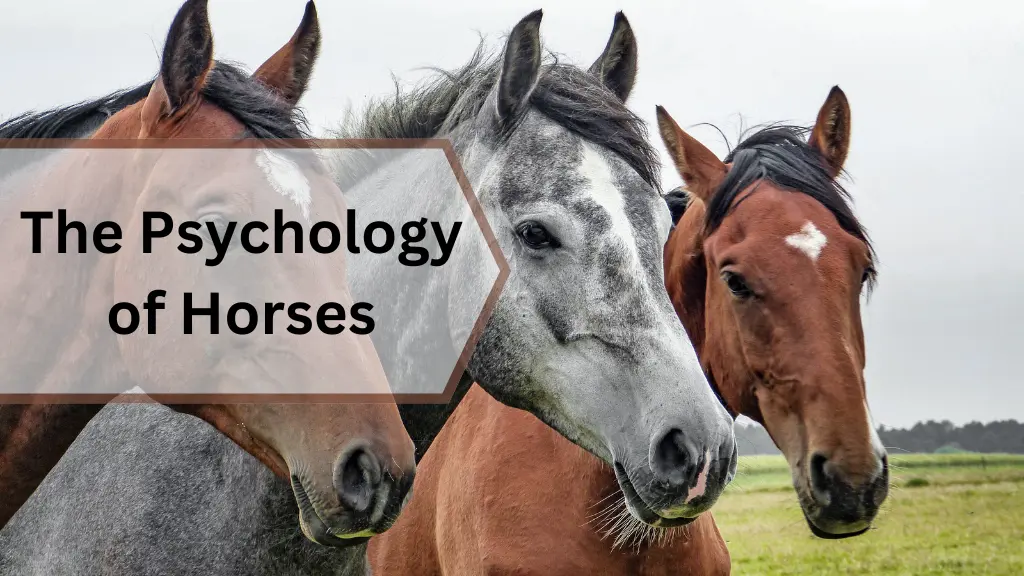The natural beauty of horses extends beyond their athletic strength since these animals demonstrate both smartness along with emotional sensitiveness and advanced communication skills. At Niche Racing, where we work closely with a fleet of horses, we have directly witnessed the complex cognitive functions of these horses during our close work.
Have you ever asked yourself what type of mental process powers the thinking of a horse? How do they see things? Their methods of expressing thoughts and emotions remain the most important issue to understand. This blog discusses an in depth overview of horse psychology to learn about their thought processes and emotional lives and communication methods.
How Do Horses Think?
Living as prey animals determines that horses process information through instincts for survival. Unlike other predators, their natural programming is flight above fight. The absence of fighting instincts does not indicate that they are only calm beings. But, every horse brings its own distinctive mindset to understanding lessons and training responses as well as environmental relations.
Thought processes of horses get influenced by these elements.
1. Instinct vs. Learning
Horses use instinctive (innate) and learned (acquired through training and experience) behavioral modes for their operations. The learning process allows horses to trust their riders and navigate obstacles thanks to instinct but these instincts make them flee in dangerous situations. We’ve seen young horses that enter our stables initially show fearfulness then grow up into polished performers through steady teaching.
2. Memory Like an Elephant!
Horses have a very good memory. They can remember locations, people, and even experiences they had in the past—both positive and negative. That is the reason proper training and positive reinforcement are the keys. In our experience, horses remember trainers they trust even after months of being apart.
3. Emotional Intelligence
Yes, emotions are indeed felt by horses. They can be happy, scared, anxious, and even attached. Studies have shown that they can recognize human feelings as well! If you feel nervous when you approach a horse with that energy, don’t be surprised if they mirror that feeling.
How Do Horses Feel?
1. Joy & Affection
Horses don’t wag their tails as dogs do, but they are just as affectionate. If a horse nuzzles you, gently rests its head on you, or follows you around, congratulations you’ve earned its trust and affection! We’ve had horses at Niche that would really be very close to their caretakers and greet them with excited knickers every morning.
2. Fear & Anxiety
As prey animals, horses are inherently very cautious. They become frightened by sudden movement, loud noise, or even an unfamiliar situation. Ever seen a horse spook at a plastic bag? That’s their survival instinct doing its job. Even our well-trained racehorses often react to nearly insignificant, unexpected changes in their surroundings.
3. Social Bonds
Horses are herd animals and naturally dislike solitude. They bond very strongly with other horses and, at times, with humans as well. Being away from their social groups can cause them anxiety like that experienced by humans when separated from family members. It has been noticed that horses refuse to eat when a favored stable companion is taken away for a race.
How Do Horses Communicate?
Horses are very vocal about their feelings, but their language is nonverbal—primarily consisting of body language, vocalizations, and subtle gestures. Let’s unravel the mystery of horse communication!
1. Ears: The Mood Barometers
- Forward ears: Interested or excited.
- Pinned back ears: Annoyed or aggressive (back off!).
- Relaxed sideways ears: Content and at ease.
2. Tail Movements: More Than Just Swishing
- Loose, swaying tail: A relaxed horse.
- Fast-swishing tail: Irritation or frustration.
- Raised tail: Excitement (or mischief incoming!).
3. Eyes & Facial Expressions
- Wide eyes with whites showing: Fear or alarm.
- Half-closed eyes: Relaxation or drowsiness.
- Flared nostrils: Excitement or mild agitation.
4. Sounds & Vocalizations
- Neigh/Whinny: Calling out to friends or seeking attention.
- Nicker: A soft, friendly sound (like a horse’s way of saying ‘hey buddy!’).
- Snort: Expressing curiosity or clearing their nostrils.
- Squeal: Usually means ‘back off!’ (common in introductions between horses).
Training Horses: Working With Their Psychology
Understanding horse psychology is crucial for effective training. Horses don’t respond to dominance, they respond to trust and consistency. Here’s how experienced trainers approach it:
1. Positive Reinforcement Wins
Horses learn best when rewarded for good behavior rather than punished for mistakes. Treats, pats, and verbal praise go a long way!
2. Build Trust, Not Fear
A scared horse is an unpredictable horse. The best trainers earn a horse’s respect and confidence rather than intimidating them. We’ve found that trust-based training produces calmer, more responsive racehorses.
3. Patience is Key
Training a horse is like building a friendship: it takes time, effort, and a whole lot of patience. Rushing or forcing them only creates resistance.
The Mind of a Horse: More Complex Than We Think
Horses aren’t just ‘dumb animals’, they are intelligent, emotional, and social beings with unique personalities. Understanding their psychology helps us communicate better, train smarter, and build stronger bonds with them. Whether you’re a seasoned rider or a horse lover, appreciating how horses think, feel, and express themselves will elevate your experience with these magnificent creatures.
Want to dive deeper into the world of horses and horse racing? Stay tuned to Niche Racing for more expert insights, training tips, and all things equestrian!

